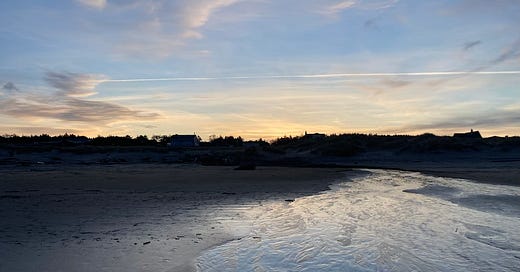News from Jules | 03.14.2022 | Seeing the Light Part 3
My body woke up before my mind—first hearing the dull roar of the waves, of the breeze through the trees, of my retreat roommate’s snore. Then the alarm clock from the room next door. I looked at my own phone: It was 4:11 a.m.
I had never been on the beach in the middle of the night, in the pitch black and I still really wanted to see what it was like.
How dark was the darkness?
I eagerly pulled back the warm comforter, crawled down from the bunk bed, tiptoed across the hall and knocked on the door. A groggy voice replied that yes, she still wanted to join me.
During the opening session on Friday, we each shared an ask and an offer for the retreat weekend. I asked for hugs. And I reiterated my regret from the other retreat two weeks ago. I shared my intention to try again if anyone wanted to come along. I knew I had expectations in the darkness.
I also knew: The breeze at dawn has secrets to tell us.
Unlike two weeks, I wasn’t scared. And I wasn’t alone. We set out in our raincoats, walking the short block to the sand dunes and onto the beach. Our eyes adjusted before we even turned on our headlamps.
“It’s not actually that dark out,” we agreed.
The moon had already set, but the Big Dipper, the Milky Way and a million visible stars flickered through hazy clouds across the whole sky. A shooting star pointed out a spot in the dark dunes where we could sit and chat and watch the white waves crash at low tide. The beach wasn’t pitch black. It was so many shades of grey.
Just like this winter actually. And where we have all been for the last two years.
Sitting in the space in between reality and faith.
That space where we see what is and we see what we hope could be, but there doesn’t seem to be a possible way to get there, much less an easy one, said Emily P. Freeman in Hold the Tension Longer, Episode 208 of The Next Right Thing podcast.
This is the tragic gap.
In March 2020, it felt like we abruptly woke up at 4 a.m.
Is this the anniversary of “the week our reality broke” as the New York Times wrote? Or was it when our delusion broke?
When we awoke from our unreality. Coming back to what is true, instead of just a brief “unprecedented” interruption of what we thought was normal life.
Two years into this global pandemic, on top of the climate catastrophe, systemic racism, war and more—there is still so much darkness.
We are not relaxed, but hyper-alert. Not alpha, but high beta waves continually crashing against our brains and our hearts. Of course, we are impatient with the mystery and angst.
Just like winter’s longer nights, it seems like it will never end.
Instead of deciding it’s impossible to move ahead, instead of settling for this side of the gap, as Freeman describes, we can hang in there and look for another way that isn’t just black and white, darkness and light.
This is our opportunity right now, as we carefully emerge this spring, yet again.
Just like we ended up sitting there for hours, watching the waves and sharing many of our tragic gaps—within our own lives, with humanity, on our planet—our eyes continually adjusting until we realized the sun had risen.
As we walked back toward the rental house, something dark emerged from the hazy storm clouds rolling ashore. Awestruck, we watched as a bald eagle glided overhead.
“Faith is the bird that feels the light when the dawn is still dark,” said Rabindranath Tagore.
I know: Not because I wish it were so, but because I’ve seen it with my own eyes.
May you keep the faith this week.
Love,
Jules



